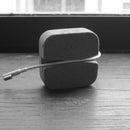Introduction: Corkedo
Corkedo is a semi flexible cork pocket for storing and protecting things. Designed to utilize the unique material characteristics of cork in a thin sheet form, Corkedo's cork and paper construction is also completely biodegradable.
Step 1: Materials and Tools
Ok, here's what you'll need to get started (optional items are marked with an asterisk):
Materials
Cork contact paper (find at Target, craft or hardware store)
Kraft paper cardstock
Cotton thread
2 Paper cilps
Scrap paper
Beeswax*
Tools
Needle
Utility knife
Pen or marker
Sewing machine*
Medium and fine sand papers
Step 2: Dimension
I fit the Corkedo in this Instructable to a pair of sunglasses, but the design can easily be modified for other applications like a cord wrap or a napkin ring. Either way, since my sunglasses are probably not the same size as yours, you'll want to first determine how big or small your Corkedo will need to be. This step is relatively easy and can be accomplished with a simple piece of scrap paper by wrapping it around the object you're going to be storing inside. This technique will give you an understanding of just how your object fits inside the tapered form. Keep in mind that you'll want a relatively snug fit, but not too snug because the cork is quite grippy. Once you've found the "sweet spot" you'll want to mark a line on the scrap paper; this will be your measurement for the inner layer of cork. The outside measurement will be about .75" longer since it will be wrapped around the inner layer and also covering the seam allowance on the inside paper layer.
My measurements came out to 4.75" x 6" for the inner layer and 4.75" x 6.75" for the outside.
Step 3: Cut the Cork
In this step you will transfer your scrap paper measurements to the cork contact paper and cut out the two layers that will eventually be bonded together. An important detail to pay attention to here is the grain of the cork. Just like paper or wood, aggregate cork sheets are constructed with a grain that results in the material being more flexible in one direction than in the other. We will use this unique characteristic to produce a flexible but semi-rigid form by alternating the grain between the outside and inside layers of cork. Since this particular form of cork is susceptible to cracking when bent at a full 180 degrees, we will cut the outside piece so that its grain is running parallel to the bend (or parallel to the shorter dimension). The inside piece should then be cut so that its grain runs perpendicular to the bend (or parallel to the longer dimension). Got it?
Step 4: Sanding
This is quite possibly the most important step in the entire project and one of my favorite discoveries while working with cork. About five to ten minutes of sanding here will produce a dramatic effect on the feel of the end product. You simply will not want to put this thing down once you've sanded it to a soft brilliant finish. Use a medium grit like 220 to start, and finish with something a bit finer. Carefully rounding the edges here will create a nice aesthetic touch when the two pieces come together at the end.
Step 5: Bond Inside Layer to Paper
Hold up! First you'll need to cut your cardstock sheet to match the dimensions of the outside layer of cork. Ok, now you're ready to adhere the inside layer of cork to the cardstock, centering it so that there is about 3/8" of paper on either side of the cork. Once it's stuck, form the pocket and paperclip it together at the top and bottom to prepare for the stitch.
Step 6: Join the Paper
So you might be wondering at this point 1) why you're about to stitch paper, and 2) why you're not stitching through the cork. The reasoning here is simple. In my own experimentation, stitching the paper yielded a more effective bond than glue, and since the cork is comprised of such a dense aggregate, stitching tended to result in cracks and tearing. I say don't fight the cork. Besides, the seamless aesthetic you get in the end is quite nice. Hand stitching works fine here, but a sewing machine will definitely speed things up. Either way, just make sure to use a wide stitch; it is paper after all (holes too close together = tear).
Step 7:
Alright, it's starting to take on shape now! Remove the paperclips for a moment and position the outer layer of cork so that the edges meet flush with the inside layer. Once you've got it all lined up, pop the paperclips back on and carefully adhere the outer layer of cork one half at a time.
Step 8: Detail Pop Stitch
Plain cork not doing it for you? Add a little more flavor to your Corkedo with a colored detail stitch. Bonus points: run the thread through a bar of beeswax before hand to achieve a cleaner stitch. Enjoy!

Participated in the
Instructables Green Design Contest













